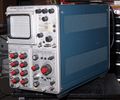560-series scopes
The 560 series scopes which were introduced with the 560 and 561 in 1961 were tube scopes that began to introduce some solid state circuitry.
They use 2-series or 3-series vertical plug-ins and 2-series or 3-series horizontal plug-ins (exception: 560 only takes 2-series because of weak power supply).
560-series mainframes contain no amplifier stages, requiring the plug-ins to drive the CRT deflection plates directly. While promoted by Tek as having the advantage of “not limited by additional circuitry between the plug-in and the deflection plates”, this configuration has a significant disadvantage in that when swapping plug-ins, gain or sweep have to be calibrated.
In scopes with amplifiers in the mainframe, touching up the gain or sweep cal when swapping plug-ins can be skipped, as doing so only tunes the accuracy to a small amount of additional precision. In the 560 series however, this step is required to even get crude accuracy, as the raw deflection factor of the CRT has a relatively large range, and the mainframe has no circuitry to normalize it.
To maintain good phase match over a wide range of frequency, the mainframe does not contain a delay line in the vertical path. The faster vertical plug-ins contain the delay line, which limits the available volume for amplifier circuitry.
560 series scopes
-
560 - Basic mainframe (1961)
-
561 (1961)
-
561A (1962)
-
564 - Storage scope (1962)
-
565 - dual-beam scope, two plug-ins; built-in trigger, sweep, and horizontal amplifier]] (1963)
-
568 - Sampling scope (1967)
560 series plugins
-
3A1S - 25 MHz vertical amplifier (1961)
-
3A7 - differential amplifier
-
3A74 - four-channel vertical plug-in (1963)
-
3A9 - 1 MHz differential amplifier (1969)
-
3B1S - timebase plug-in (1961)
-
3L5 - 1 MHz spectrum analyzer
-
3S1 - dual-trace sampling plug-in
-
3S3 - sampling plug-in
-
3S7 - sampling plug-in (1971)
-
3S76 - dual-trace sampling plug-in
-
3T7 - sampling timebase and pulser (1971)

















